Mitigation of Condensate Banking Using Thermochemical Treatment: Experimental and Analytical Study
Abstract
:1. Introduction
2. Experimental Approach
2.1. Materials
2.2. Coreflooding Setup
3. Results and Discussion
3.1. Condensate Removal
3.2. Generation of Micro-Fractures
3.3. Gas Relative Permeability
3.4. Enhancement of Gas Mobility
4. Conclusions
- Thermochemical treatment removes more than 65% of the condensate banking, utilizing viscosity reduction and immiscible mechanisms.
- The huff and Puff mode showed better performance than continuous chemical injection in mitigating the condensate damage and minimizing the injected chemicals.
- Removing the condensate banking improves the gas effective permeability. The relative permeability to gas was improved by a factor of 1.22 using the thermochemical treatment.
- The pressure pulse generated due to the reaction and the high temperature created micro-fractures in the tight sandstone. Tiny fractures were observed in all samples after the chemical treatment.
- Injecting thermochemical fluids improved the gas mobility by reducing the condensate viscosity and enhancing the gas effective permeability. The hydrocarbon viscosity was reduced 17 times using thermochemical treatment.
- The reduction in capillary pressure due to thermochemical treatment was determined, and a reduction of 51% in the capillary forces was achieved. The values of capillary pressure before and after treatment were 65.5 and 32.4 psi, respectively.
- Combining the improvement in capillary forces with the reduction of fluid viscosity revealed that the ultimate enhancement in hydrocarbon mobility would reach 94%.
Author Contributions
Funding
Acknowledgments
Conflicts of Interest
Nomenclature
| kr | relative permeability |
| Pc | capillary pressure, psi |
| Scon | condensate saturation |
| Sconr | residual condensate saturation |
| Sgc | critical gas saturation |
| Sgr | residual gas saturation |
| Swi | irreducible water saturation |
| μ | viscosity, cP |
| ϕ | porosity |
References
- Chai, J.; Shi, H.; Zhou, X.; Wang, S. The Price Elasticity of Natural Gas Demand in China: A Meta-Regression Analysis. Energies 2018, 11, 3255. [Google Scholar] [CrossRef]
- Fevang, Φ.; Whitson, C.H. Modeling Gas-Condensate Well Deliverability. SPE Reserv. Eng. 1996, 11, 221–230. [Google Scholar] [CrossRef]
- Marokane, D.; Logmo-Ngog, A.B.; Sarkar, R. Applicability of timely gas injection in gas condensate fields to improve well productivity. In Proceedings of the SPE/DOE Improved Oil Recovery Symposium, SPE75147, Tulsa, OK, USA, 13–17 April 2002. [Google Scholar] [CrossRef]
- Sayed, M.A.; Al-Muntasheri, G.A. Mitigation of the effects of condensate banking: A critical review. SPE Prod. Oper. 2016, 31, 85–102. [Google Scholar] [CrossRef]
- Alvarado, V.; Manrique, E. Enhanced oil recovery: An update review. Energies 2010, 3, 1529–1575. [Google Scholar] [CrossRef]
- Al-Anazi, H.; Xiao, J.J.; Al-Eidan Ahmed, A.; Buhidma Ismail, M.; Ahmed Mahbub, S.; Al-Faifi Mohammad, G.; Assiri Wisam, J. Gas Productivity Enhancement by Wettability Alteration of Gas-Condensate Reservoirs. In Proceedings of the European Formation Damage Conference, SPE107493, Scheveningen, The Netherlands, 30 May–1 June 2007. [Google Scholar] [CrossRef]
- Wang, D.; Shi, F.; Yu, B.; Sun, D.; Li, X.; Han, D.; Tan, Y. A Numerical Study on the Diversion Mechanisms of Fracture Networks in Tight Reservoirs with Frictional Natural Fractures. Energies 2018, 11, 3035. [Google Scholar] [CrossRef]
- Du, L.; Walker, J.G.; Pope, G.A.; Sharma, M.M.; Wang, P. Use of solvents to improve the productivity of gas condensate wells. In Proceedings of the SPE Annual Technical Conference and Exhibition, SPE62935, Dallas, TX, USA, 1–4 October 2000. [Google Scholar] [CrossRef]
- Al-Anazi, H.; Al-Otaibi, M.; Al-Faifi, M.; Hilab, V. Enhancement of Gas Productivity Using Alcoholic Acids: Laboratory and Field Studies. In Proceedings of the SPE Annual Technical Conference and Exhibition, SPE102383, San Antonio, TX, USA, 24–27 September 2006. [Google Scholar] [CrossRef]
- Al-Anazi, H.A.; Pope, G.A.; Sharma, M.M.; Metcalfe, R.S. Laboratory measurements of condensate blocking and treatment for both low and high permeability rocks. In Proceedings of the SPE Annual Technical Conference and Exhibition, SPE77546, San Antonio, TX, USA, 29 September–2 October 2002. [Google Scholar] [CrossRef]
- Asgari, A.; Dianatirad, M.; Ranjbaran, M.; Sadeghi, A.R.; Rahimpour, M.R. Methanol treatment in gas condensate reservoirs: A modeling and experimental study. Chem. Eng. Res. Des. 2014, 92, 876–890. [Google Scholar] [CrossRef]
- Khan, M.N.; Siddiqui, F.I.; Mansur, S. Hydraulic Fracturing in Gas Condensate Reservoirs: Successes, Setbacks and Lessons Learnt. In Proceedings of the SPE/PAPG Annual Technical Conference, SPE142848, Islamabad, Pakistan, 10–11 November 2010. [Google Scholar] [CrossRef]
- Franco, C.A.; Solares, J.R.; Asiri, K.S.; Shammari, N.; Alabbad, E.A.; Gomez, A.; Antonio, F. Optimization of Conventional Acid Jobs and the Historical Trend Leading to Multi-Stage Acid Fracturing Stimulation to Increase Gas-Condensate Productivity in Carbonate Reservoirs in Saudi Arabia. In Proceedings of the SPE Middle East Oil and Gas Show and Conference, SPE141339, Manama, Bahrain, 25–28 September 2011. [Google Scholar] [CrossRef]
- EPA. Hydraulic Fracturing for Oil and Gas: Impacts from the Hydraulic Fracturing Water Cycle on Drinking Water Resources in the United States; Executive Summary; EPA: Washington, DC, USA, 2018.
- Sänger, P.; Hagoort, J. Recovery of gas condensate by nitrogen injection compared with methane injection. SPEJ 1998, 3, 26–33. [Google Scholar] [CrossRef]
- Hoier, L.; Cheng, N.; Whitson, C.H. Miscible gas injection in under saturated gas–oil systems. In Proceedings of the SPE Annual Technical Conference and Exhibition, SPE 90379, Houston, TX, USA, 26–29 September 2004. [Google Scholar] [CrossRef]
- Zhang, Y.; Di, Y.; Shi, Y.; Hu, J. Cyclic CH4 Injection for Enhanced Oil Recovery in the Eagle Ford Shale Reservoirs. Energies 2018, 11, 3094. [Google Scholar] [CrossRef]
- Odi, U. Analysis and Potential of CO2 Huff-n-Puff for Near Wellbore Condensate Removal and Enhanced Gas Recovery. In Proceedings of the SPE Annual Technical Conference and Exhibition, SPE160917, San Antonio, TX, USA, 8–10 October 2012. [Google Scholar] [CrossRef]
- Su, Z.; Tang, Y.; Ruan, H.; Wang, Y.; Wei, X. Experimental and modeling study of CO2—Improved gas recovery in gas condensate reservoir. Petroleum 2017, 3, 87–95. [Google Scholar] [CrossRef]
- Al-Anazi, H.A.; Pope, G.A.; Sharma, M.M. Laboratory measurement of condensate blocking and treatment for both low and high permeability rocks. In Proceedings of the SPE Annual Technical Conference and Exhibition, San Antonio, TX, USA, 29 September–2 October 2002. [Google Scholar]
- Corey, A.T. The interrelation between gas and oil relative permeabilities. Prod. Mon. 1954, 19, 38–41. [Google Scholar]
- Brooks, R.H.; Corey, A.T. Hydraulic Properties of Porous Media; Hydrology Papers, No. 3; Colorado State University: Fort Collins, CO, USA, 1964; pp. 22–27. [Google Scholar]
- Honarpour, M.; Koederitz, L.; Harvey, A.H. Relative Permeability of Petroleum Reservoirs; CRC Press: Boca Raton, FL, USA, 1986; pp. 16–41. [Google Scholar]
- Henderson, G.D.; Danesh, A.; Tehrani, D.H.; Al-Shaidi, S.; Peden, J.M. Measurement and Correlation of Gas Condensate Relative Permeability by the Steady-State Method. SPE Reserv. Eval. Eng. 1998, 1. [Google Scholar] [CrossRef]
- Ibrahim, M.N.M. Two-Phase Relative Permeability Prediction Using a Linear Regression Model. Ph.D. Thesis, University of Missouri-Rolla, Rolla, MO, USA, 1999. [Google Scholar]

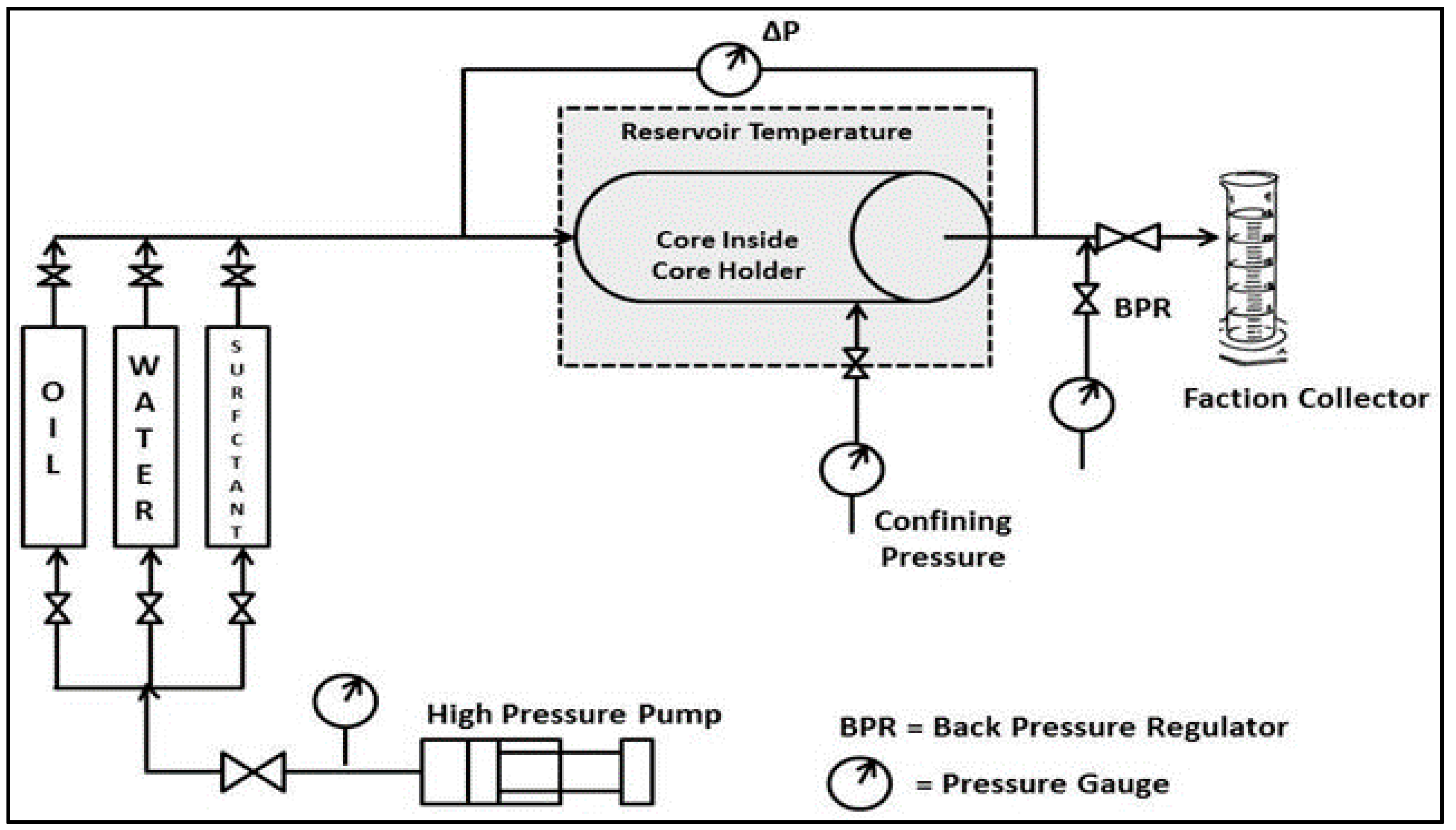
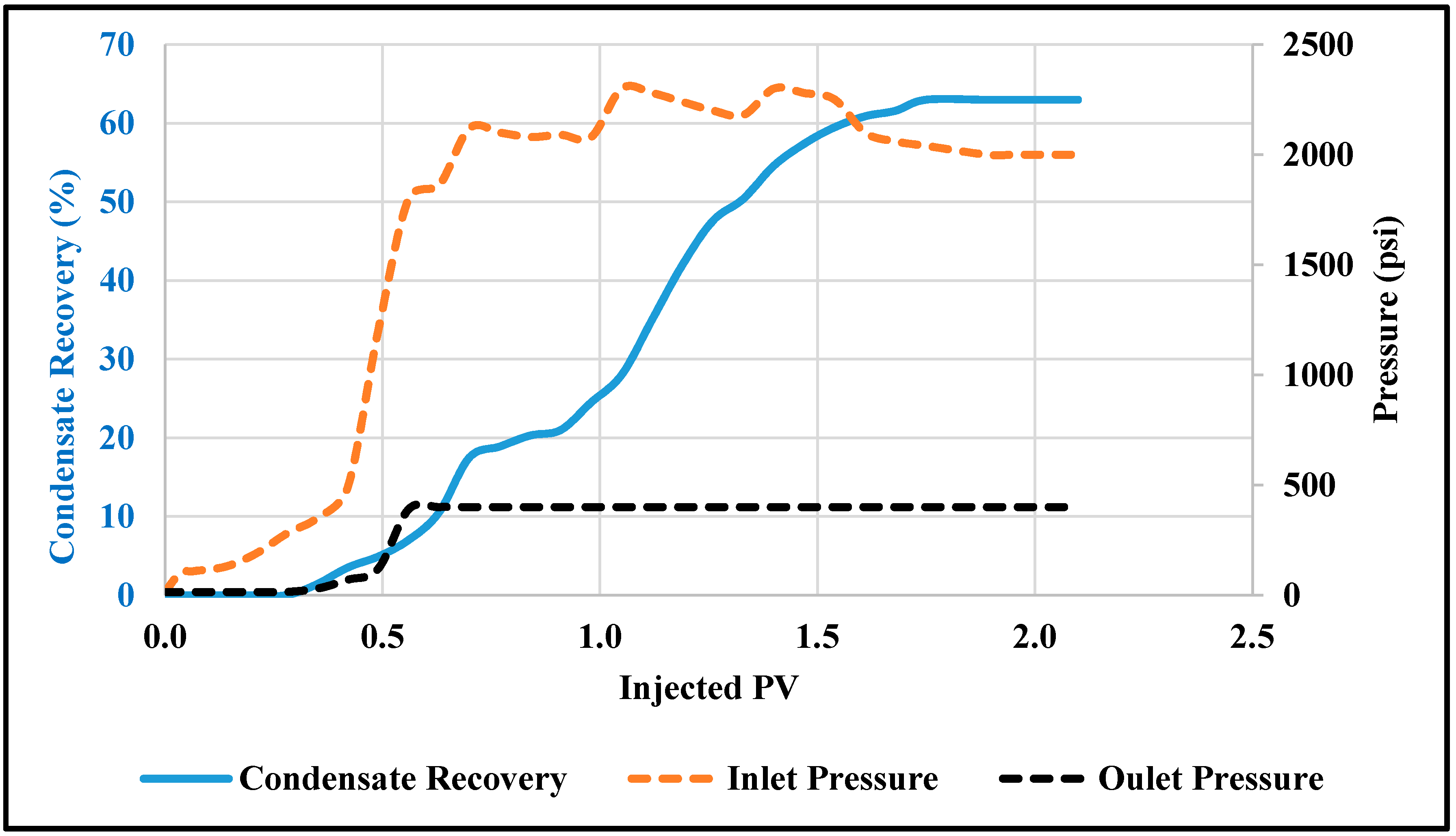

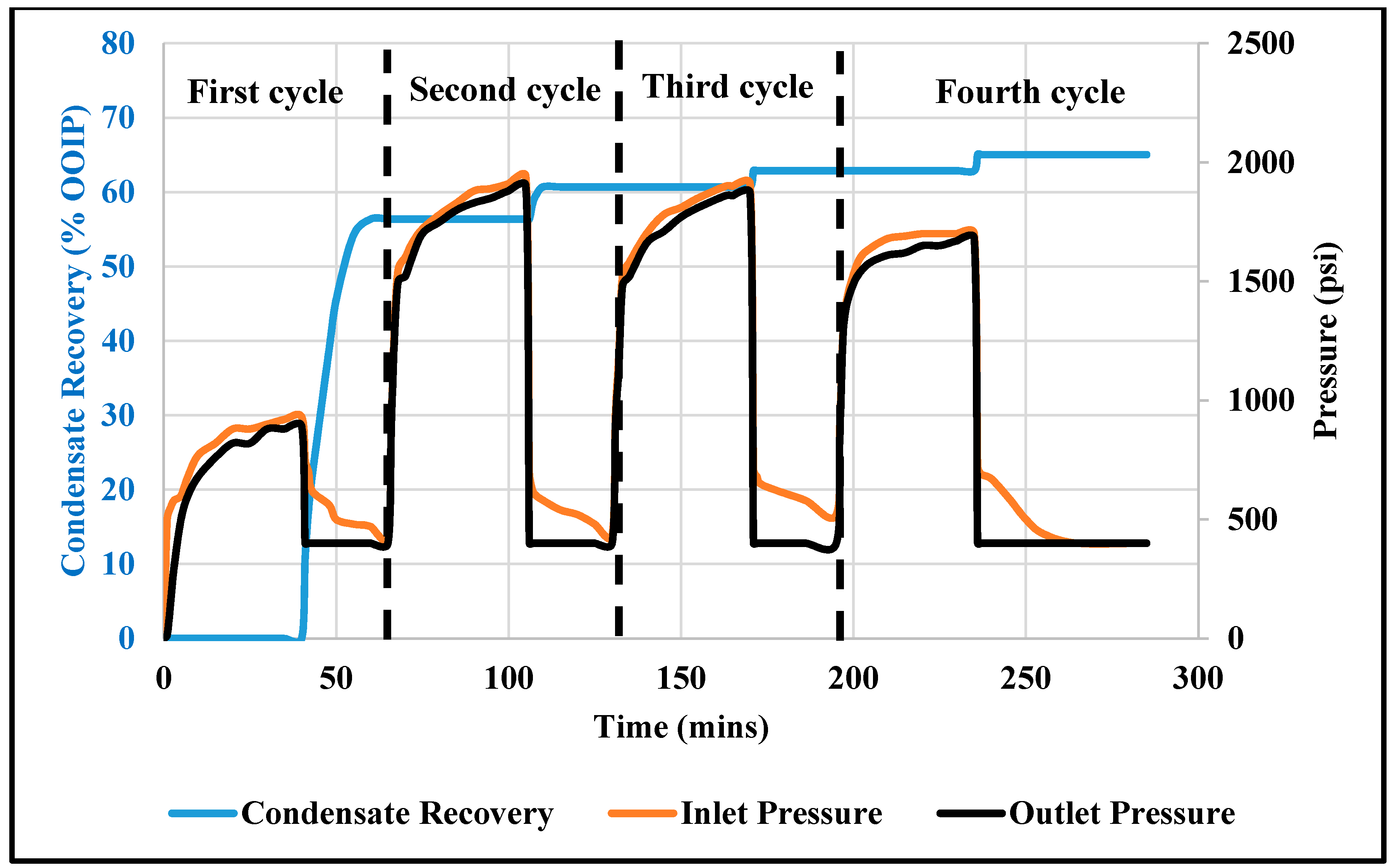
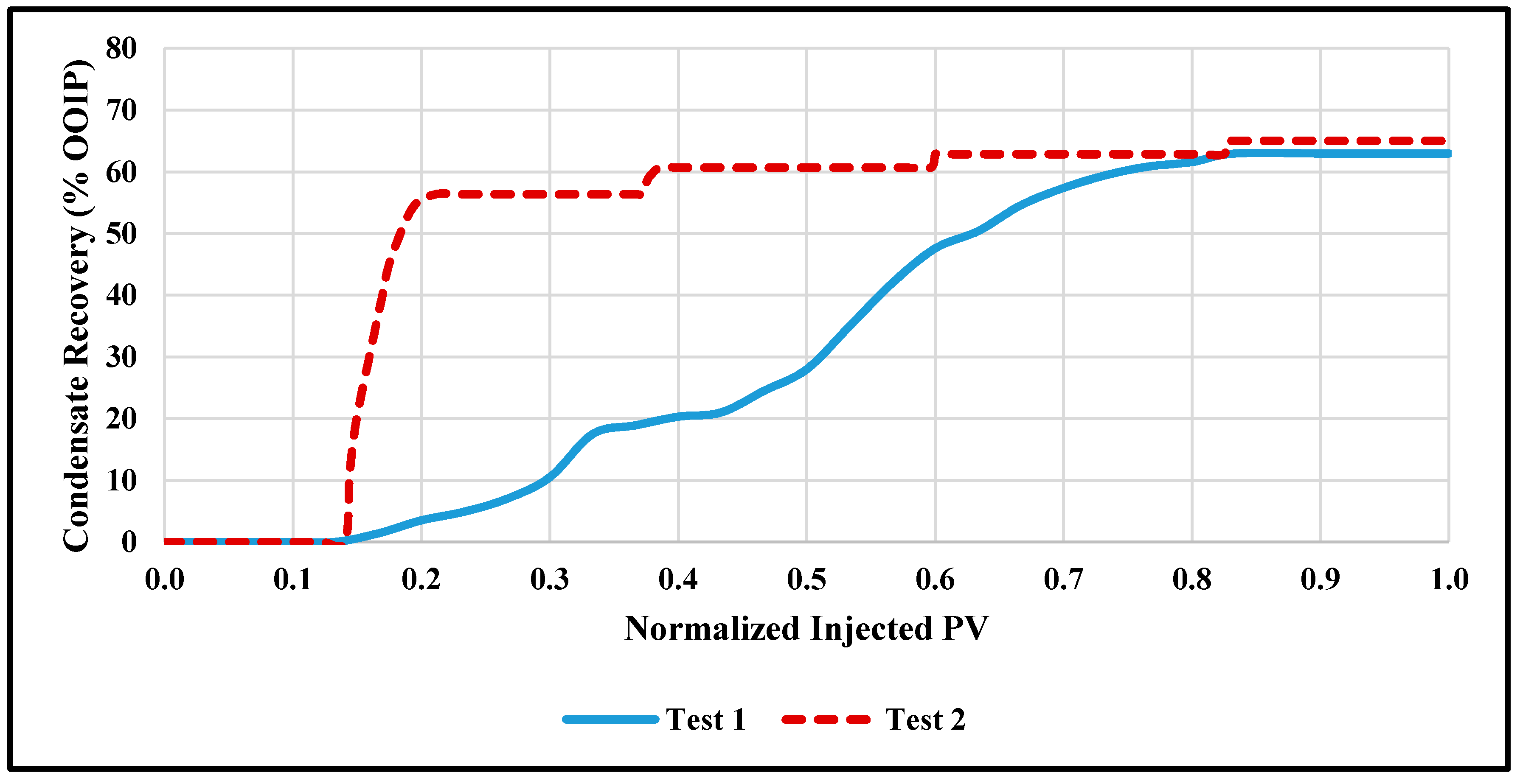
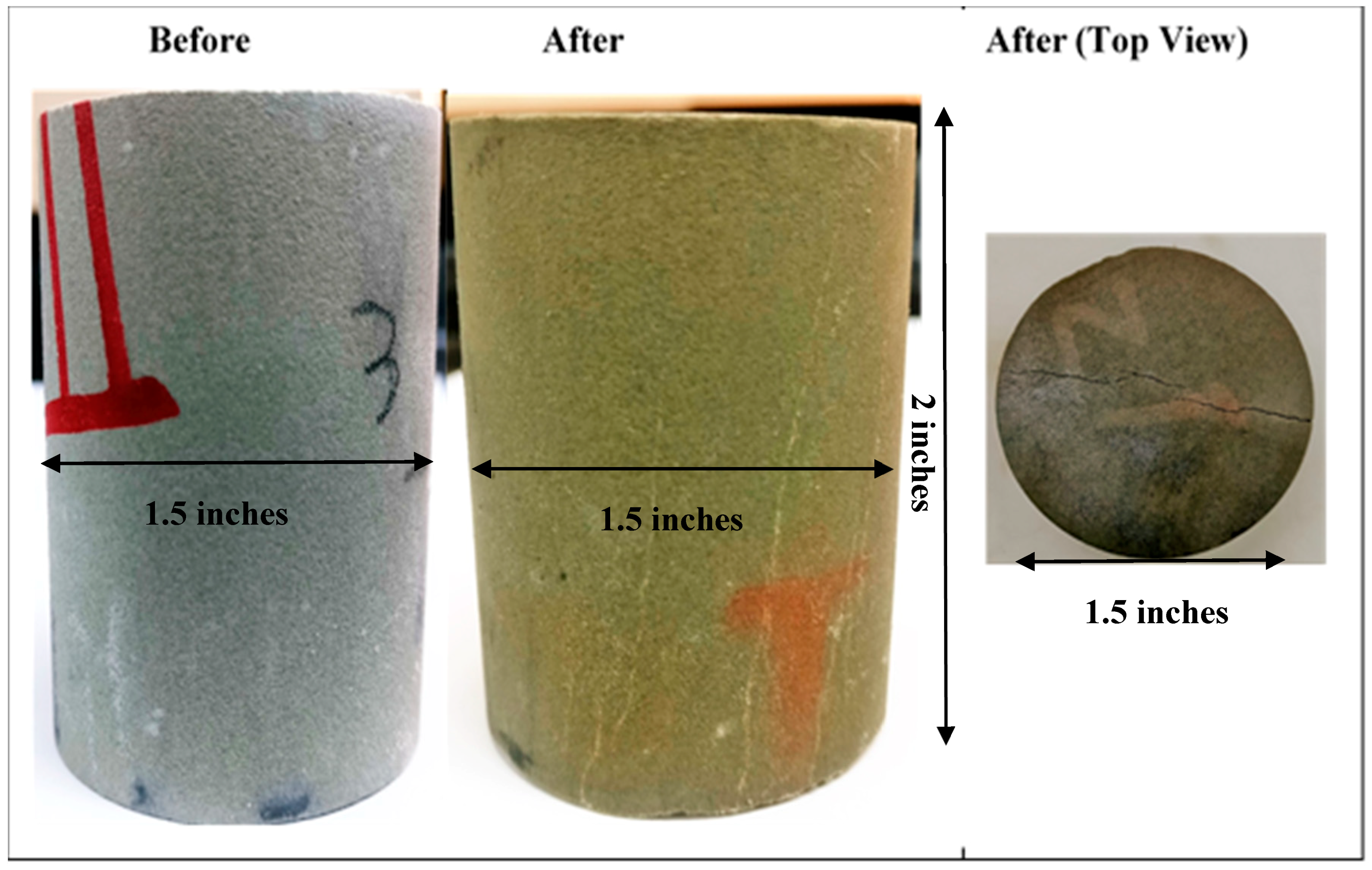
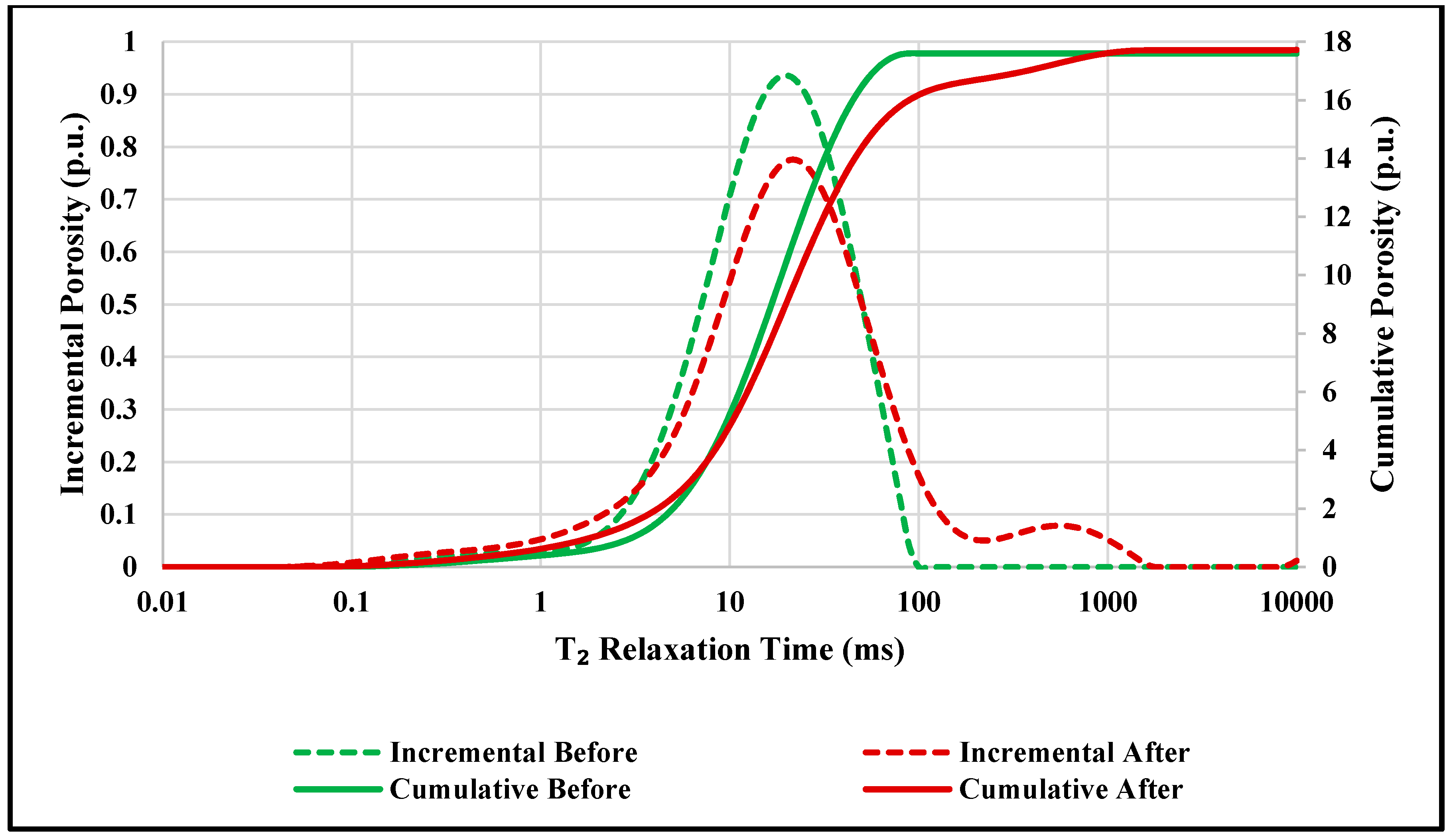
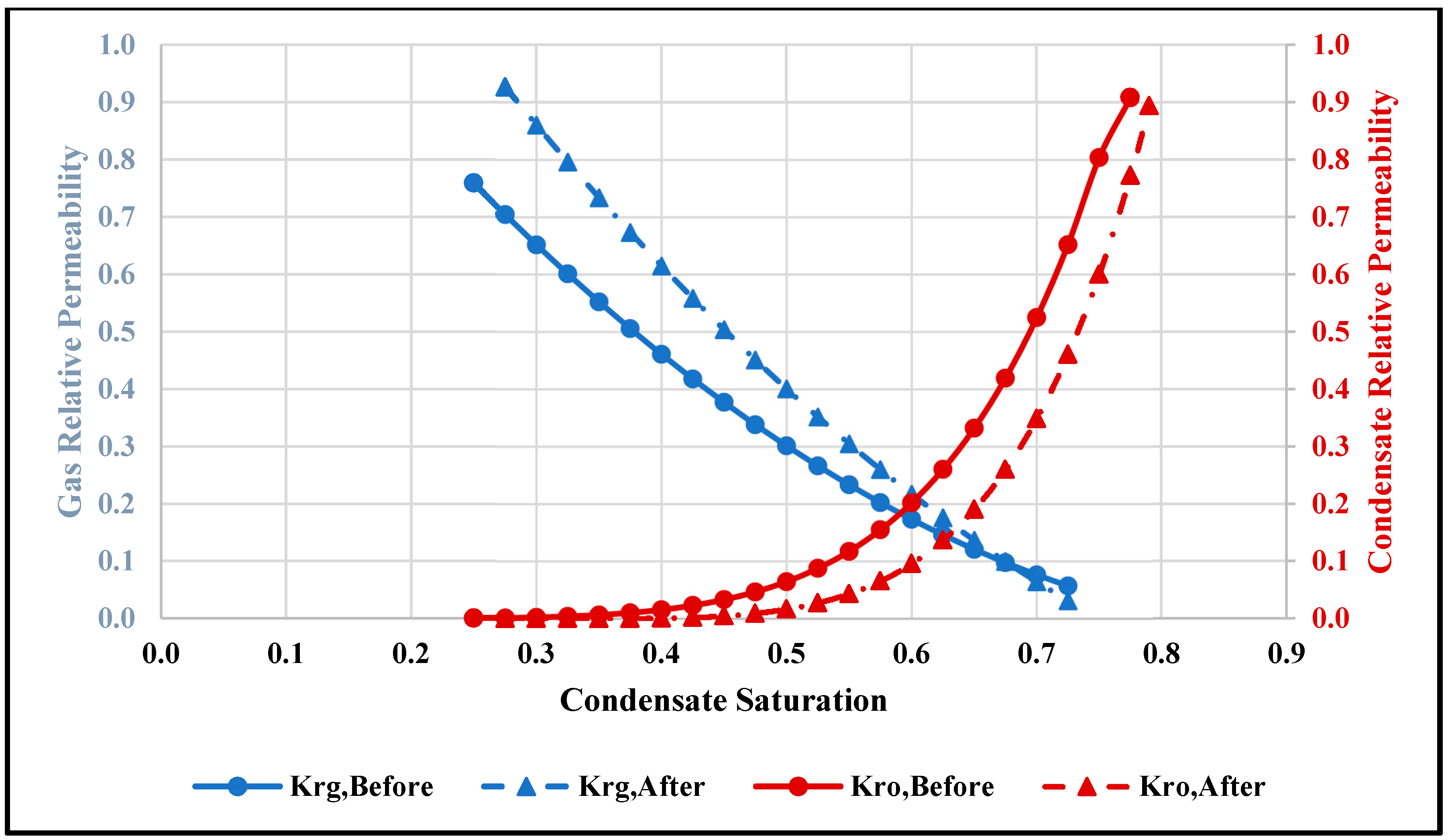

| Sample ID | Diameter (cm) | Length (cm) | Bulk Volume (mL) | Pore Volume (mL) | Porosity (%) | Absolute Permeability (mD) |
|---|---|---|---|---|---|---|
| 1 | 3.81 | 7.34 | 83.72 | 14.29 | 17.07 | 0.898 |
| 2 | 3.81 | 2.54 | 28.95 | 4.61 | 15.93 | 0.900 |
© 2019 by the authors. Licensee MDPI, Basel, Switzerland. This article is an open access article distributed under the terms and conditions of the Creative Commons Attribution (CC BY) license (http://creativecommons.org/licenses/by/4.0/).
Share and Cite
Hassan, A.M.; Mahmoud, M.A.; Al-Majed, A.A.; Al-Nakhli, A.R.; Bataweel, M.A.; Elkatatny, S. Mitigation of Condensate Banking Using Thermochemical Treatment: Experimental and Analytical Study. Energies 2019, 12, 800. https://doi.org/10.3390/en12050800
Hassan AM, Mahmoud MA, Al-Majed AA, Al-Nakhli AR, Bataweel MA, Elkatatny S. Mitigation of Condensate Banking Using Thermochemical Treatment: Experimental and Analytical Study. Energies. 2019; 12(5):800. https://doi.org/10.3390/en12050800
Chicago/Turabian StyleHassan, Amjed M., Mohamed A. Mahmoud, Abdulaziz A. Al-Majed, Ayman R. Al-Nakhli, Mohammed A. Bataweel, and Salaheldin Elkatatny. 2019. "Mitigation of Condensate Banking Using Thermochemical Treatment: Experimental and Analytical Study" Energies 12, no. 5: 800. https://doi.org/10.3390/en12050800
APA StyleHassan, A. M., Mahmoud, M. A., Al-Majed, A. A., Al-Nakhli, A. R., Bataweel, M. A., & Elkatatny, S. (2019). Mitigation of Condensate Banking Using Thermochemical Treatment: Experimental and Analytical Study. Energies, 12(5), 800. https://doi.org/10.3390/en12050800







